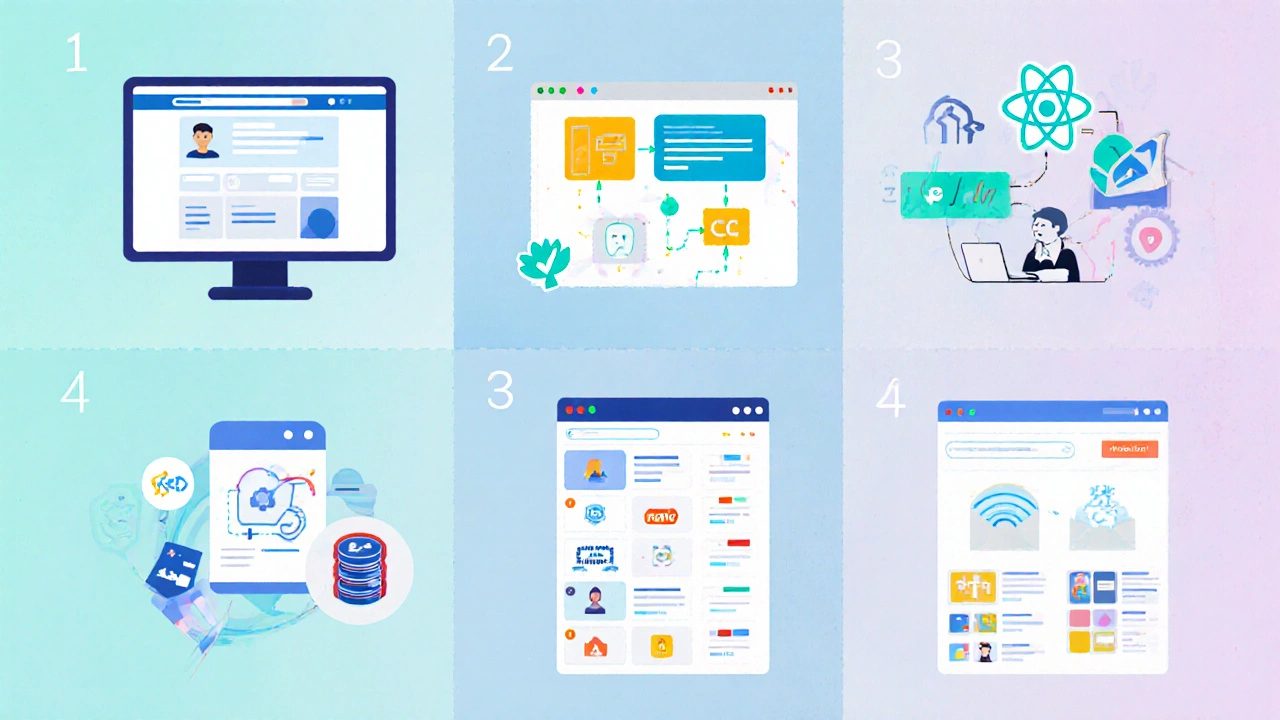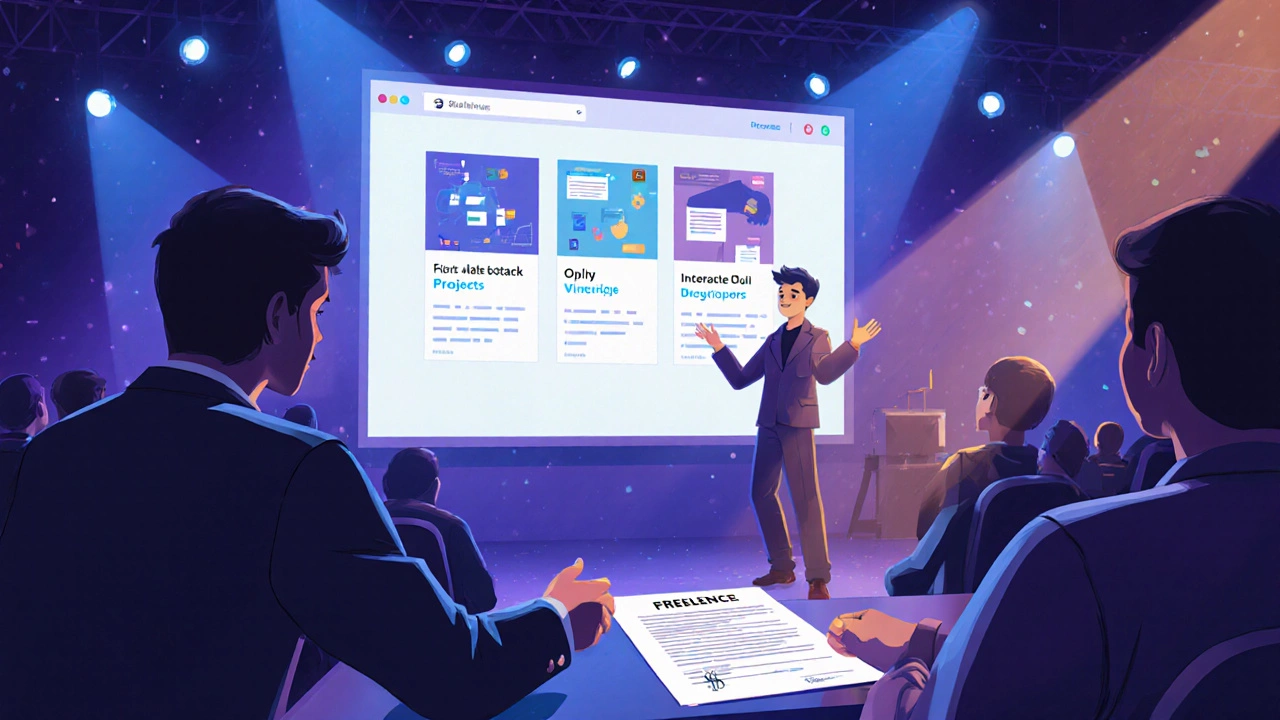Web Developer Timeline Calculator
Personalized Roadmap Calculator
See how your weekly study hours affect your 2-year development timeline
Enter your weekly hours to see your personalized timeline
Ever wondered if you can swap your current job for a web developer career in just two years? The answer is yes-if you follow a clear plan, stay disciplined, and focus on the skills employers actually need.
What a Web Developer Actually Does
Before you map out a timeline, it helps to know the day‑to‑day reality. A Web Developer writes, tests, and maintains code that powers websites and web applications can specialize in three main areas:
- Frontend - turning designs into interactive pages using HTML, CSS, and JavaScript.
- Backend - building servers, APIs, and databases that handle data and business logic.
- Full‑stack - a blend of both, enabling you to deliver complete solutions on your own.
Most junior roles expect you to be comfortable with the frontend stack and at least one backend language. Full‑stack is a bonus but not a prerequisite.
Choosing the Right Learning Path
There are three common routes:
| Path | Time Investment | Cost (USD) | Typical Outcome |
|---|---|---|---|
| Self‑Study | 12‑24 months (flexible) | 0‑500 (free resources + books) | Entry‑level junior role, strong portfolio |
| Coding Bootcamp | 3‑6 months intensive + 6‑12 months practice | 7,000‑15,000 (often with job‑guarantee) | Junior or mid‑level role, employer‑backed placement |
| University Degree | 3‑4 years full‑time | 15,000‑30,000 (varies by institution) | Broader CS foundation, may lead to senior roles faster |
For a two‑year target, self‑study combined with a short bootcamp for mentorship works best. It gives you flexibility, lowers cost, and still provides the structured feedback many learners need.
Quarter‑by‑Quarter Roadmap
Break the 24‑month span into six 4‑month blocks. Each block has a clear goal, a set of deliverables, and a weekly time budget (aim for 15‑20 hours/week if you’re working full‑time).
- Months 1‑4: Foundations
- Learn HTML5 semantics, CSS3 layout (Flexbox, Grid).
- Complete JavaScript the core language for browser interactivity basics - variables, functions, DOM manipulation.
- Set up Git version control system for tracking code changes and create a GitHub account.
- Deliverable: a personal website featuring a blog, contact form, and responsive design.
- Months 5‑8: Intermediate Frontend
- Dive into a modern framework - React a popular UI library for building component‑based interfaces (or Vue/Angular if you prefer).
- Learn CSS preprocessors (Sass) and component libraries (Bootstrap, Tailwind).
- Build 2‑3 portfolio projects: a todo app, a weather dashboard, and an e‑commerce product page.
- Deliverable: a polished portfolio site showcasing these projects with source code on GitHub.
- Months 9‑12: Backend Basics
- Pick a server‑side language - Node.js (JavaScript) is a natural choice, or PythonFlask/Django for variety.
- Understand RESTful API design, CRUD operations, and authentication (JWT).
- Get comfortable with a relational database (PostgreSQL) and basic SQL queries.
- Deliverable: a full‑stack blog API consumed by the React frontend built earlier.
- Months 13‑16: Advanced Topics & Real‑World Practice
- Explore testing (Jest for frontend, Mocha/Chai for backend) and CI/CD pipelines (GitHub Actions).
- Learn basic cloud deployment - Netlify for static sites, Render or Heroku for full‑stack apps.
- Take a short Coding Bootcamp intensive program focusing on project work and interview prep (4‑6 weeks) for mentorship and networking.
- Deliverable: a deployed SaaS‑style app (e.g., a simple task manager) with real users.
- Months 17‑20: Portfolio Polish & Soft Skills
- Write case studies for each project - problem, solution, tech stack, results.
- Learn to write a developer‑focused resume and LinkedIn profile.
- Practice common interview questions (whiteboard algorithms, system design).
- Deliverable: a live portfolio with SEO‑friendly URLs and a downloadable PDF resume.
- Months 21‑24: Job Hunt & Continuous Learning
- Apply to at least 10 junior positions per week - use job boards, recruiters, and referrals.
- Attend local meetups (e.g., Bristol Web Dev community) and virtual conferences.
- Pick a niche skill to deepen (e.g., TypeScript, GraphQL, or accessibility).
- Deliverable: land a junior or entry‑level web developer role, or secure a paid freelance contract.
Stick to the timeline, track progress weekly, and adjust based on feedback. The roadmap is flexible; the goal is consistent forward motion.

Key Tools and Resources You’ll Need
Here’s a cheat‑sheet of the most useful services, all of which have free tiers for beginners:
- Code editor: Visual Studio Code (VSCode) - extensions for linting, Git, and live server.
- Version control: Git + GitHub (or GitLab) for hosting repositories.
- Learning platforms: freeCodeCamp, MDN Web Docs, YouTube channels (TraversyMedia, The Net Ninja).
- Bootcamp options: General Assembly, Le Wagon, Thinkful - all offer part‑time, remote tracks.
- Design basics: Figma (free starter), Adobe XD - helpful for creating UI mockups before coding.
- Deployment: Netlify (static sites), Render (full‑stack), Railway (databases).
Having these tools set up early saves you from scrambling later.
Common Pitfalls and How to Dodge Them
Even the most motivated learners hit snags. Spot these early and you’ll stay on track:
- Spreading too thin. Focus on one stack at a time - frontend first, then backend.
- Skipping projects. Theory without practice won’t impress recruiters. Build, ship, iterate.
- Neglecting soft skills. Communication, teamwork, and time management are often the tie‑breaker in interviews.
- Relying on one resource. Mix videos, docs, and interactive coding challenges to keep learning fresh.
- Ignoring the job market. Regularly check job listings to see which technologies are in demand and adjust your focus accordingly.

What Success Looks Like After Two Years
If you follow the roadmap, you’ll have:
- A live portfolio with at least three full‑stack projects.
- Proficiency in HTML, CSS, JavaScript, React, Node.js (or another backend language), Git, and a relational database.
- A polished resume and LinkedIn profile that highlight measurable achievements.
- Hands‑on experience from a bootcamp, freelance gigs, or an internship.
- At least one job offer or a steady stream of freelance contracts.
That’s a realistic, evidence‑based outcome for a committed learner.
Next Steps: Your Personal Action Plan
Grab a notebook or a digital board and copy the quarterly milestones above. Fill in exact dates, pick the resources you like best, and set a weekly review reminder. The sooner you write it down, the more likely you’ll act on it.
Frequently Asked Questions
Do I need a computer science degree to become a web developer?
No. Most junior roles care about practical skills and a solid portfolio. A degree can help with algorithms, but self‑study + projects are enough for hiring managers.
How many hours per week should I study?
Aim for 15‑20 hours if you work full‑time. Consistency beats marathon sessions; a regular schedule builds momentum.
Is a coding bootcamp worth the cost?
If you need structure, mentorship, and job‑placement assistance, a reputable bootcamp can accelerate your path. Look for transparent curricula and alumni outcomes before enrolling.
What’s the best way to showcase my projects?
Host the live demo, link the source on GitHub, and write a short case study (problem, tech stack, result). A clean portfolio site that’s mobile‑friendly makes a strong impression.
How do I prepare for technical interviews?
Practice coding challenges on LeetCode or HackerRank, review common data‑structure questions, and rehearse system‑design scenarios. Pair‑programming with a friend boosts confidence.


